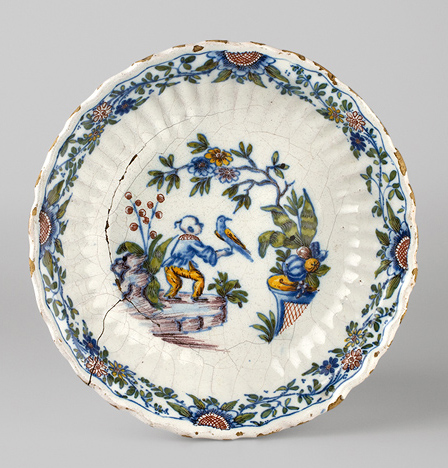
Technically, faience (tin-glazed earthenware or delftware) is earthenware with varying amounts of iron and a yellow, pink or reddish fabric when fired; a certain amount of lime is necessary for the glaze to adhere to the body (Maggetti 2007; Maggetti 2012). After the first firing, also known as biscuit firing, both the interior and exterior of the vessel are dipped in a lead-tin glaze. It is the tin that makes the glaze opaque. The glaze is usually the defining criterion for faience.
There is only one exception to this rule, though it is problematic in terms of its definition; that is when the body of the vessel consists of a clay that fires white or a light colour and is lacking in iron but rich in lime, and based on its composition, should really be called (white-bodied) “lime-rich industrial earthenware”. Such lime-rich industrial earthenware with faience glaze is known, e.g., from the pottery manufacture of Kilchberg-Schooren ZH (Matter 2012, 99-100, Tab. 1-3) and various production sites in France (e.g. Niderviller or Saint-Clément: Maggetti 2017, 106-107 and Maggetti 2023). The problem, from today’s perspective, arises when the body or fabric (= white-bodied industrial earthenware) is used as the main criterion for classification rather than the glaze (= faience).
So-called high-fire glazes can be used to apply the decorations (in-glaze painting) to faience. A second firing (glost firing at 1000–1190 °C) results in the colours fusing with the glaze. The vessel can then be painted again, this time using overglaze colours, after which it may be covered with an additional coat of transparent shiny lead glaze (“coperta”). The third firing is carried out in a muffle kiln at a temperature of 650–850 °C. The range of colours include cobalt blue, manganese purple, copper green, Naples or antimony yellow, iron brown or iron red.
Simple faience produced in large quantities and often hastily painted was considered “… luxury tableware for the middle classes, the better off tradesmen, farmers, merchants, officials and low-ranking clergy…” who usually possessed only a few individual pieces of true porcelain.
Translation Sandy Haemmerle
English: Faience (if tin-glazed on both surfaces), tin-glazed earthenware (if tin-glazed only on the side on view), Delftware
German: Fayence
French: Faïence
References on faience production:
Bartels 1999
Michiel Bartels, Steden in Scherven, Zwolle 1999, 201-236
Blondel 2001
Nicole Blondel, Céramique: vocabulaire technique, Paris 2001, 75-81.
Guyot 2018
Claude Guyot, Étude des terres de pipe, formes et décors entre faïence et porcelaine. Lunéville 2018.
Heege 2016
Andreas Heege, Die Ausgrabungen auf dem Kirchhügel von Bendern, Gemeinde Gamprin, Fürstentum Liechtenstein. Bd. 2: Geschirrkeramik 12. bis 20. Jahrhundert, Vaduz 2016, 271-288.
Maggetti 2007
Marino Maggetti, Technique de la faïence française (fin XVIIIe/debut XIXe siècle), in: Marino Maggetti (Hrsg.), La faïence de Fribourg: 1753-1844, Dijon 2007, 14-31.
Maggetti 2012
Marino Maggetti, Technology and Provenancing of French faience, in: José Miguel Herrero/Marius Vendrell, XXXII Reunión de la Sociedad Espanola de Mineralogía. International seminar on Archaeometry and Cultural Heritage: the contribution of Mineralogy, Bilbao, 27 de Junio 2012 (Seminarios de la Sociedad Espanola de Mineralogía 9), Mdrid 2012, 41-64.
Maggetti 2017
Marino Maggetti, Technologische Analyse eines frühen (1800-1806) Matzendorfer Steinguts, in: Keramik-Freunde der Schweiz, Mitteilungsblatt 131, 2017, 105-123.
Maggetti 2023
Faïence ou terre blanche? Le Bois d’Épense ou Saint-Clément? Keramikfreunde der Schweiz Bulletin 101, 25-31.
Matter 2012
Annamaria Matter, Die archäologische Untersuchung in der ehemaligen Porzellanmanufaktur Kilchberg-Schooren. Keramikproduktion am linken Zürichseeufer 1763-1906 (Monographien der Kantonsarchäologie Zürich 43), Zürich 2012.

